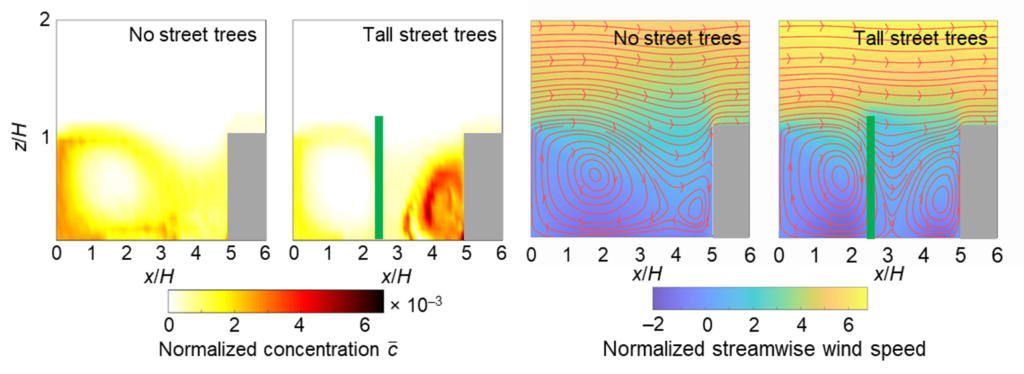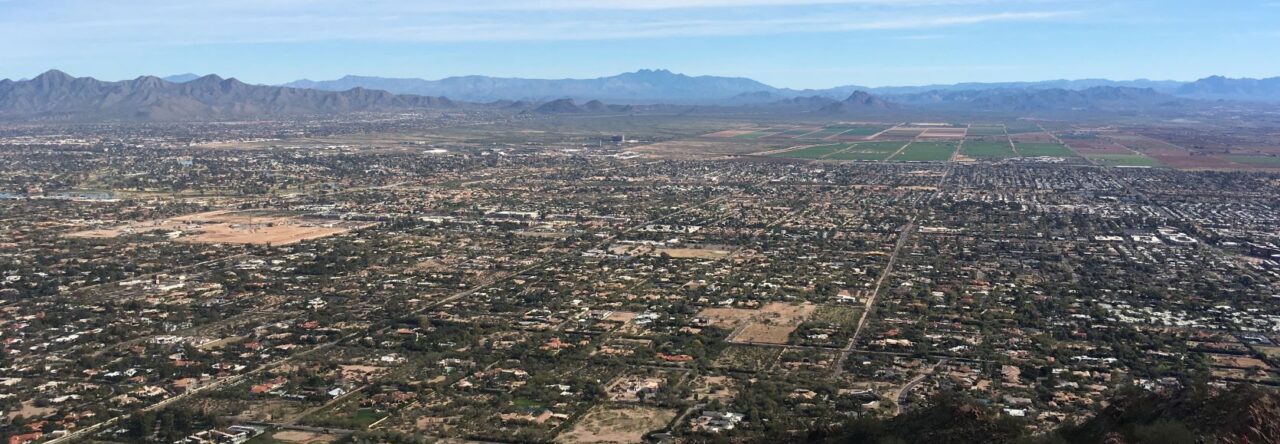Urban Canopy Model
Despite recent advances in the development of land surface models, the heterogeneous urban environment and its components are oversimplified in many global and regional climate models. We have developed urban canopy models to improve the predictive capability of urban hydrometeorological and climate simulations across multiple spatial scales.
One particular missing component in many global and regional climate models is street trees. We have developed the Arizona State University Single-Layer Urban Canopy Model (ASLUM) version 3.1 (Wang et al., 2021). In addition to urban features such as walls, roads, roofs, ground vegetation, roof vegetation, and irrigation, ASLUM version 3.1 enables the simulations of multiple biophysical functions of urban trees, including radiative shading, canopy transmittance, evapotranspiration, and root water uptake.

Both ASLUM v3.1 and its previous version v2.0 have recently participated in an international multi-site model intercomparison project led by the University of Reading and the Met Office.
We have also coupled a simplified version of the ASLUM v3.1 into the mesoscale Weather Research and Forecasting (WRF) model to examine the influence of shade trees on urban hydroclimate and pedestrian thermal comfort in all U.S. cities (Wang et al., 2018), demonstrating the cooling effect of urban shade trees across the country.
Urban Heat Mitigation
With continuous urbanization, cities are at a greater risk of heat stress, especially during heat wave events. We use numerical simulations to examine the effectiveness of various urban heat mitigation measures, including engineering solutions, such as cool roofs and pavements, and nature-based solutions, such as green roofs and trees. Our goal is to identify locally tailored best practices for cities to alleviate heat stress and improve their resilience and sustainability.
The figure below is from one of our heat mitigation studies on urban irrigation over green spaces using the WRF model (Wang et al., 2019), which shows the near-surface air temperature change due to urban irrigation over the contiguous U.S. The results have been used to derive a practical metric, urban water capacity, to quantify the average irrigation depth needed to achieve one degree of urban temperature reduction.

Turbulent Transport and Dispersion
The complex geometry of the urban environment poses great challenges to predicting the transport and dispersion of airborne pollutants emitted from near-surface sources. Traditional analytical models are often inadequate to resolve the influence of buildings and trees on the near-surface flow field, whereas computational fluid dynamics models can be quite computationally expensive.
To improve the efficiency of pollutant transport and dispersion modeling over complex terrains (e.g., urban environments), we have developed an integrative modeling framework that couples Large-Eddy Simulation (LES) and a Lagrangian Stochastic particle dispersion Model (LSM).
The figure below is from an application of the coupled LES-LSM model, in which we examined how various geometries and characteristics of buildings and street trees can impact the flow field and the distribution of air pollutants emitted from traffic (Wang et al., 2018).

Relevant publications:
- Lipson, M. J., Grimmond, S., Best, M., Abramowitz, G., Coutts, A., Tapper, N., Baik, J.-J., Beyers, M., Blunn, L., Boussetta, S., Bou-Zeid, E., De Kauwe, M. G., de Munck, C., Demuzere, M., Fatichi, S., Fortuniak, K., Han, B.-S., Hendry, M., Kikegawa, Y., Kondo, H., Lee, D.-I., Lee, S.-H., Lemonsu, A., Machado, T., Manoli, G., Martilli, A., Masson, V., McNorton, J., Meili, N., Meyer, D., Nice, K. A., Oleson, K. W., Park, S.-B., Roth, M., Schoetter, R., Simón-Moral, A., Steeneveld, G.-J., Sun, T., Takane, Y., Thatcher, M., Tsiringakis, A., Varentsov, M., Wang, C., Wang, Z.-H., & Pitman, A. (2023). Evaluation of 30 urban land surface models in the Urban-PLUMBER project: Phase 1 results. Quarterly Journal of the Royal Meteorological Society, early view version online.
- Huang, X., Song, J., Wang, C., & Chan, P. W. (2022). Realistic representation of city street-level human thermal stress via a new urban climate-human coupling system. Renewable and Sustainable Energy Reviews, 169, 112919.
- Huang, X., Song, J., Wang, C., Chui, T. F. M., & Chan, P. W. (2021). The synergistic effect of urban heat and moisture islands in a compact high-rise city. Building and Environment, 205, 108274.
- Wang, C., Wang, Z.-H., & Ryu, Y.-H. (2021). A single-layer urban canopy model with transmissive radiation exchange between trees and street canyons. Building and Environment, 191, 107593.
- Wang, C. (2020). Landscape phenology and soil moisture dynamics influenced by irrigation in a desert urban environment. In Ghaffarianhoseini, A., Ghaffarianhoseini A., and Nasmith N. (Eds.), Imaginable Futures: Design Thinking, and the Scientific Method, pp. 670–679.
- Yang, J., Hu, L., & Wang, C. (2019). Population dynamics modify urban residents’ exposure to extreme temperatures across the United States. Science Advances, 5(12), eaay3452.
- Wang, C., Wang, Z.-H., & Yang, J. (2019). Urban water capacity: Irrigation for heat mitigation. Computers, Environment and Urban Systems, 78, 101397.
- Wang, C., Li, Q., & Wang, Z.-H. (2018). Quantifying the impact of urban trees on passive pollutant dispersion using a coupled large-eddy simulation–Lagrangian stochastic model. Building and Environment, 145, 33–49.
- Wang, C., Wang, Z.-H., & Yang, J. (2018). Cooling effect of urban trees on the built environment of contiguous United States. Earth’s Future, 6(8), 1066–1081.
- Song, J., Wang, Z.-H., & Wang, C. (2018). The regional impact of urban heat mitigation strategies on planetary boundary-layer dynamics over a semiarid city. Journal of Geophysical Research: Atmospheres, 123(12), 6410–6422.
- Wang, C., Wang, Z.-H., Yang, J., & Li, Q. (2018). A backward-Lagrangian-stochastic footprint model for the urban environment. Boundary-Layer Meteorology, 168, 59–80.
- Song, J., Wang, Z.-H., & Wang, C. (2017). Biospheric and anthropogenic contributors to atmospheric CO2 variability in a residential neighborhood of Phoenix, Arizona. Journal of Geophysical Research: Atmospheres, 122(6), 3317–3329.
- Wang, Z.-H., Fan, C., Myint, S. W., & Wang, C. (2016). Size matters: What are the characteristic source areas for urban planning strategies? PLoS One, 11(11), e0165726.
